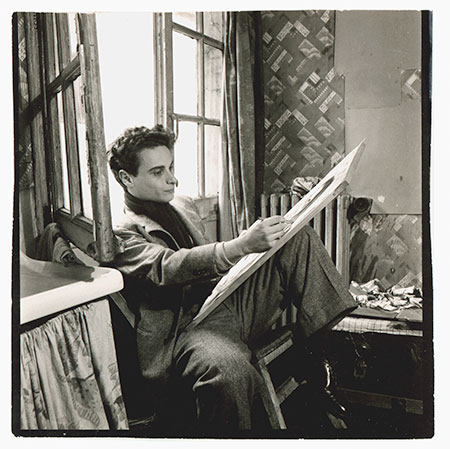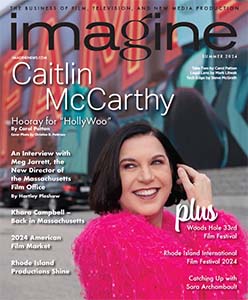By Hartley Pleshaw

“Arthur Polonsky, in Paris from Life Magazine 1948” Taken by Nat Farbman for the 1948 international edition of LIFE Magazine. Arthur was there on a 2-year traveling fellowship from the School of the Boston Museum of Fine Arts
For his upcoming documentary film, Gabriel Polonsky had the perfect subject: a talented, innovative, renowned artist. It was also a subject he had close proximity to: the artist in question is his own father. So one would think it would all be easy, and simple to tell the story.
Until, that is, he started to learn the story. As he began making a film about his father, Arthur Polonsky, Gabriel wound up teaching himself about his father’s life and work as well as a little-known, but seminal group of mid-20th century artists known collectively as the “Boston Expressionists.”
“I’m making this film for many different reasons. Five years ago I went to a movie at the Museum of Fine Arts, about a prominent Boston painter named Hyman Bloom—also an Expressionist— who was a friend of my father’s. My father was briefly in the film, and I thought, ‘where is the full story on my father and the group of other key artists in their circles?’
“(My father) has had an interesting life. His work is breathtaking. He’s one of the best artists I’ve ever seen, and I would think so even if he wasn’t my father. Yet he never quite attained the recognition he deserved, nor has the movement. I want to expose his art and that of the other Boston Expressionists to a whole new audience.
“So I decided that when my father turned eighty five, I’d go over to his house and just start filming. It was now or never. At first I didn’t have a plan; I just knew that he’s a fascinating character. He’s brilliant, funny, and has an amazing story to tell: from son of Russian immigrant tailors in Lynn, MA, to an MFA scholarship recipient painting in Paris with friends like Ellsworth Kelly in 1948.
Amazing, also, to his son, is the environment in which his father works, and what he does with it.
“He lives in this unusual house. It’s sort of a ‘Grey Gardens’ style Victorian house that’s decaying around him, while he’s still creating this beautiful art work in it. He does these really crazy “Rube Goldberg” household repairs. He took the radiator hose from his 1962 Renault, and attached it to the two faucets in the Victorian marble bathroom sink, to mix the hot and cold water.
“I think that these DYI repairs are as interesting and beautiful as his paintings that hang in museums. But what is most unusual is to capture him painting, which is a rare gift; he has never opened his studio and artistic process to the public before.”
Thus inspired, Gabriel Polonsky began filming his father’s story—and, in the process, learning about it.
“I didn’t know much about his career. He didn’t talk about it when I was growing up, or maybe I wasn’t listening very much.
“The movie took a much different course than I ever expected, growing much larger than I ever anticipated and it is generating a lot of interest. Almost every museum and university I speak to, including the MFA and ICA, has asked to screen it once it is completed. And I am amazed and grateful for all of the help and support we’ve received from the Boston film and art communities. So, this is quite a journey for me as well.”
How did Gabriel’s vision for the film change from his original idea? “I started learning about this whole movement of Boston Expressionist painters, my father’s role in it, and realized that though their work is held in prominent collections, they are little known by the broader public.
I learned about his world of art—all these amazing people he’s known since the 1940’s. Curators, collectors, other painters, authors, former students.”
“Every inch of his house is full of art, towering stacks of news clippings, photos, books and articles about his career and the history of art in Boston since the 1940’s—it’s a virtual museum. And at 88, he is still painting and having major exhibitions.
“So I go over to shoot cinema verite footage of my father at home, drawing and painting. He starts opening up about his life before he had the family, as a young artist, and to his journey as an artist now in his late 80’s. I realized that my father, and the artists’ movement he helped initiate, was a much deeper, broader subject than I had known about.
“As I began interviewing other people, one of the first was Nick Capasso, who at the time was head curator of the DeCordova Museum. I asked him, ‘Tell me something about Arthur Polonsky.’ He said, ‘Arthur Polonsky was one of the most important Boston painters of the 20th Century… period.’ That amazed me. So, I decided to set out for the next two years with my camera to find out exactly what Nick meant.
“I ended up doing over thirty interviews. I spoke with Boston’s leading curators, collectors, authors, my father’s former students, and my whole family of artists.”
Why did it take the production of this film to allow Gabriel Polonsky to learn so much about his father? “It was a combination of things. As with many kids I wasn’t listening to a lot of what my dad said when I was younger! Also, he was very modest and self-deprecating, and for certain reasons, he just didn’t talk about that part of his life very much when I was growing up.
“Both of my parents are artists. They had studios in the house. It was creative chaos. My father made etchings in the bathtub with nitric acid. I would see them working, and I would go to their art openings, but I didn’t quite ‘get it.’ I was eight years old, and my father would take me to museums with his work hanging on the wall. These interesting artists and students would come up and tell me how much they adored him and admired his work. They had this long history with him that I wasn’t familiar with. He taught at Boston University for twenty-five years, and Brandeis before that and at the Boston Museum School for eleven years before that.
“These were parts of his life that were all connected, and were outside of the way I knew him as a father.”
In particular, the “Boston Expressionism” movement which is recognized by curators and academics is not always accepted by the artists themselves. Like many of his fellow artists from that period, my father rejects the title ‘Expressionist,’ they don’t really call themselves anything but ‘painters!’
“But it does describe a way of working and a style that many of them were doing, though not always with intentionality.
“I almost feel that now I have a PhD in the history of Boston Expressionism. Not by reading about it in books, but by talking to the surviving people who lived it and wrote about it. And my father was one of the prominent Boston Expressionists. He played a major role in creating this artistic movement since the late 1940’s, and he’s still part of it.”
And What is Expressionism?
“The simple answer is that (Expressionism) is a type of art or painting that’s done from imagination, and frequently involves the figure. It’s different from Abstract Expressionism, which was popular at the time, and came out of New York with Jackson Pollock, (Willem) de Kooning and (Mark) Rothko among others. Those artists’ paintings were nearly devoid of the figure. Expressionism often has dreamlike, imaginary, distorted figures. The brushwork is usually coarse, agitated and dramatic, and the colors are vibrant. There’s sort of a mystical, emotional theme to it. These are words often used to describe my father’s work.”
And how did one particular form of Expressionism emerge in Boston?
“Boston Expressionism really started in the 1940’s at the Boston School of the Museum of Fine Arts. Before and after the war, some of the prominent European Expressionists came over and began the program. The majority of Boston Expressionists were first generation Americans from Eastern Europe. Many of them were Jewish; my father’s parents emigrated from Russia. (Arthur Polonsky grew up in Lynn, Massachusetts.) They studied Expressionism, and created this historic movement in American art. But, it was unheralded. It never reached its due and hasn’t been promoted to the extent that Abstract Expressionism has.”
But according to Gabriel Polonsky, it was in Boston, not New York, where Expressionism first took root in America. “They were called ‘The Bad Boys of Boston.’ They were breaking all the rules. Some of my father’s work looks like a beautiful nightmare. At the time, it was disturbing and controversial. They were changing art.”
From what Gabriel has learned, it is almost a historical accident that this movement began in Boston; it just happened to be the place where so many of these European immigrant artists came from. But there were some aspects of Arthur’s Lynn, MA boyhood that may well have influenced his later artistic visions. “There were big marshes near the Saugus Iron Works. They used to burn off the dead grass to prevent natural brush fires. He saw that when he was a kid, and he liked the color of the fire. So, that may be the reason that he incorporates fire into many works. Of course, the reviewers see that, and say, ‘Polonsky has this raging inferno from within, that comes from deep inside his psyche.’ This makes him laugh.
“My father and I went back to Lynn, with a camera crew. We drove around while he told stories about growing up there. We went to the Lynn Public Library where he spent much of his childhood. On the wall is an enormous, painted mural that depicts the creation of man, with angels and cavemen. When my father saw that mural as a little kid he said to himself, ‘I want to be a painter. I want to be able to do that.’ So, I had to film him returning to the library to see the mural once again, while talking about how it inspired a lifetime of painting”
Fortunately for Gabriel, one of the important periods in his father’s life was already on film—film that he was able to use in his documentary.
“When he graduated (from the Boston Museum School), my father received a two-year fellowship to the booming art scene of post-WW II Paris. That was a life-changing experience for him. It was an amazing time. He lived up the street from Picasso and drew every day with friends like the aforementioned Ellsworth Kelly. Arthur was featured in LIFE Magazine, had acclaimed international solo shows, and was in group shows with Pollock and Picasso. From what I’ve learned about it, my father lived a real-life Woody Allen MIDNIGHT IN PARIS experience.
“He had a girlfriend in Paris and did many beautiful drawings and paintings of her. I found out that she’s alive and well, and living in Massachusetts. So, I ended up doing a great interview with her and struck gold! She had this amazing B&W 8mm movie footage of them in Paris together. All these artists in the street, it’s like a Fellini movie. My father is young and handsome, with his pipe. She’s in the footage, too. It’s an incredible document of an era to include in the film.”
Also in the film will be scenes describing the impact that Arthur Polonsky’s work—and that of other Boston Expressionists—has today, and the following that their work has attracted. Among such followers is Katherine French, Head of the Danforth Museum, Arthur’s friend and lifelong collector, Carol Klein, and Boston’s Herbert Grey, known as one of the biggest private collectors and an admirer of Boston Expressionism. Such people are in the vanguard of a revival of interest in Boston Expressionism, which Gabriel’s film, inevitably, will spotlight. There is little doubt that the completion of this film will raise the profile and value of these works. According to Gabriel, this film is the first feature length film which will cover Boston Expressionism.
As for Gabriel’s own career, the Boston native has his own extensive portfolio of work as a filmmaker, artist, animator, and educator. In 1992, he founded Gabriel Polonsky Studio. (Gabriel’s awards include a national Emmy nomination.) The documentary film about his father is the Studio’s latest production.
The film’s working title is RELEASE FROM REASON. It comes from a statement Arthur Polonsky gave in an interview: “In a world where reason is the goal, I think that art is the release from reason.”
The film has completed all primary filming and production work, has over 150 hours of interviews and scenes recorded and is now raising funds to begin post-production. Gabriel Polonsky can be contacted directly at info@releasefromreason. com, or by calling 617 515-5642. Updates are available at http://releasefromreason.com/news/.
Hartley Pleshaw has been a writer for IMAGINE since 2006. He has worked in Boston-area media and theater for over three decades. His email address is: [email protected].








